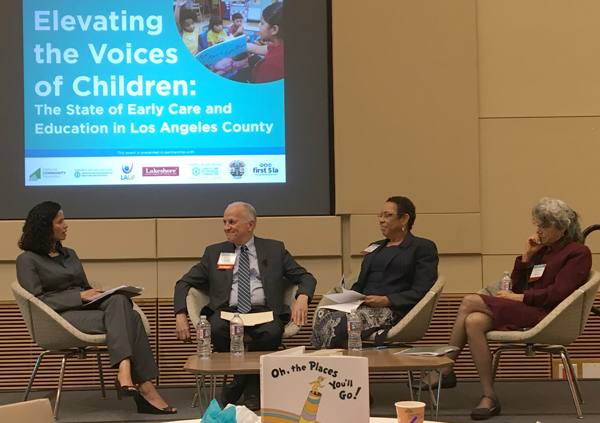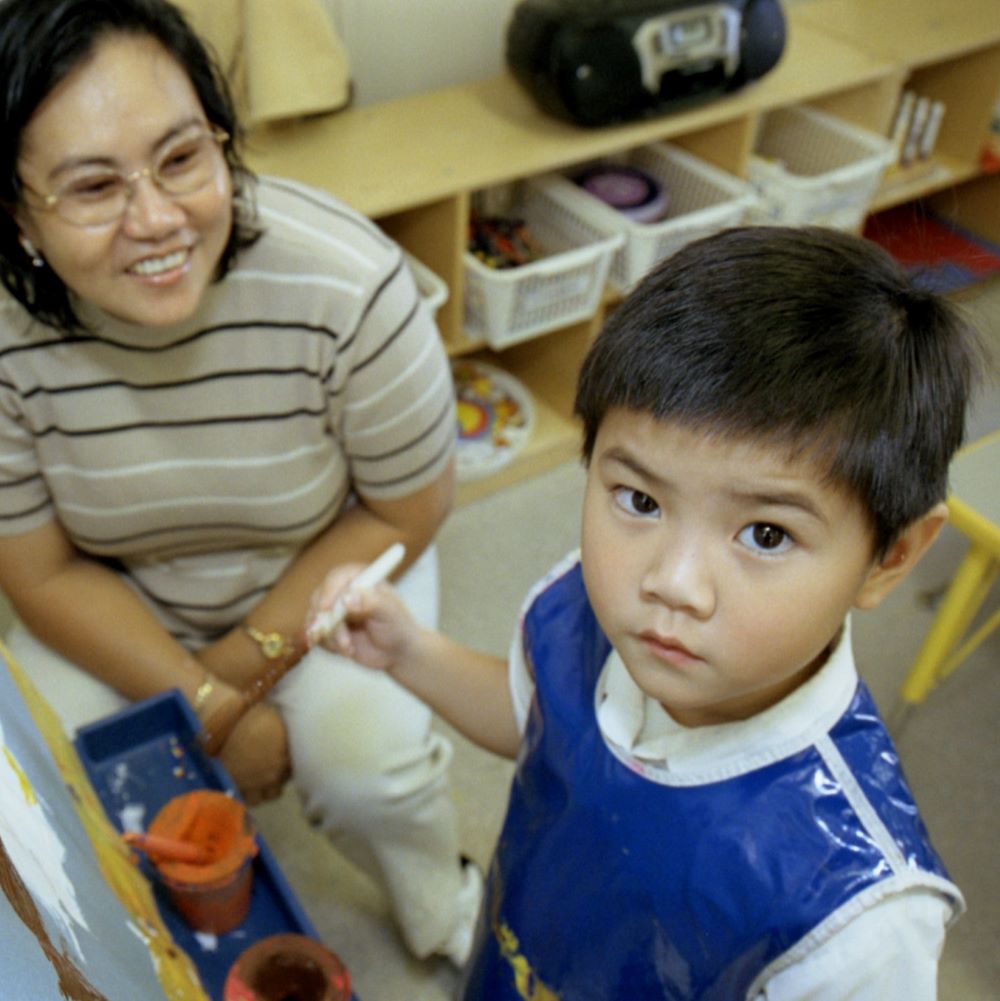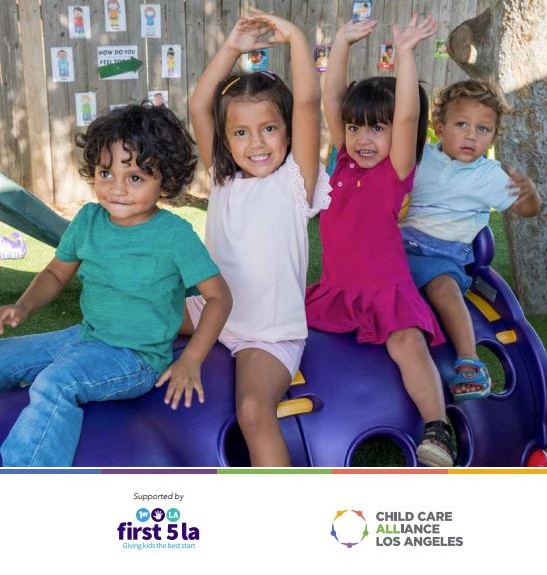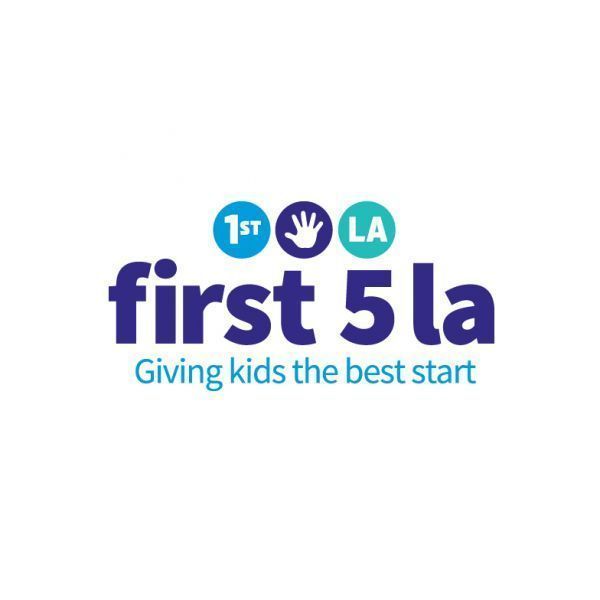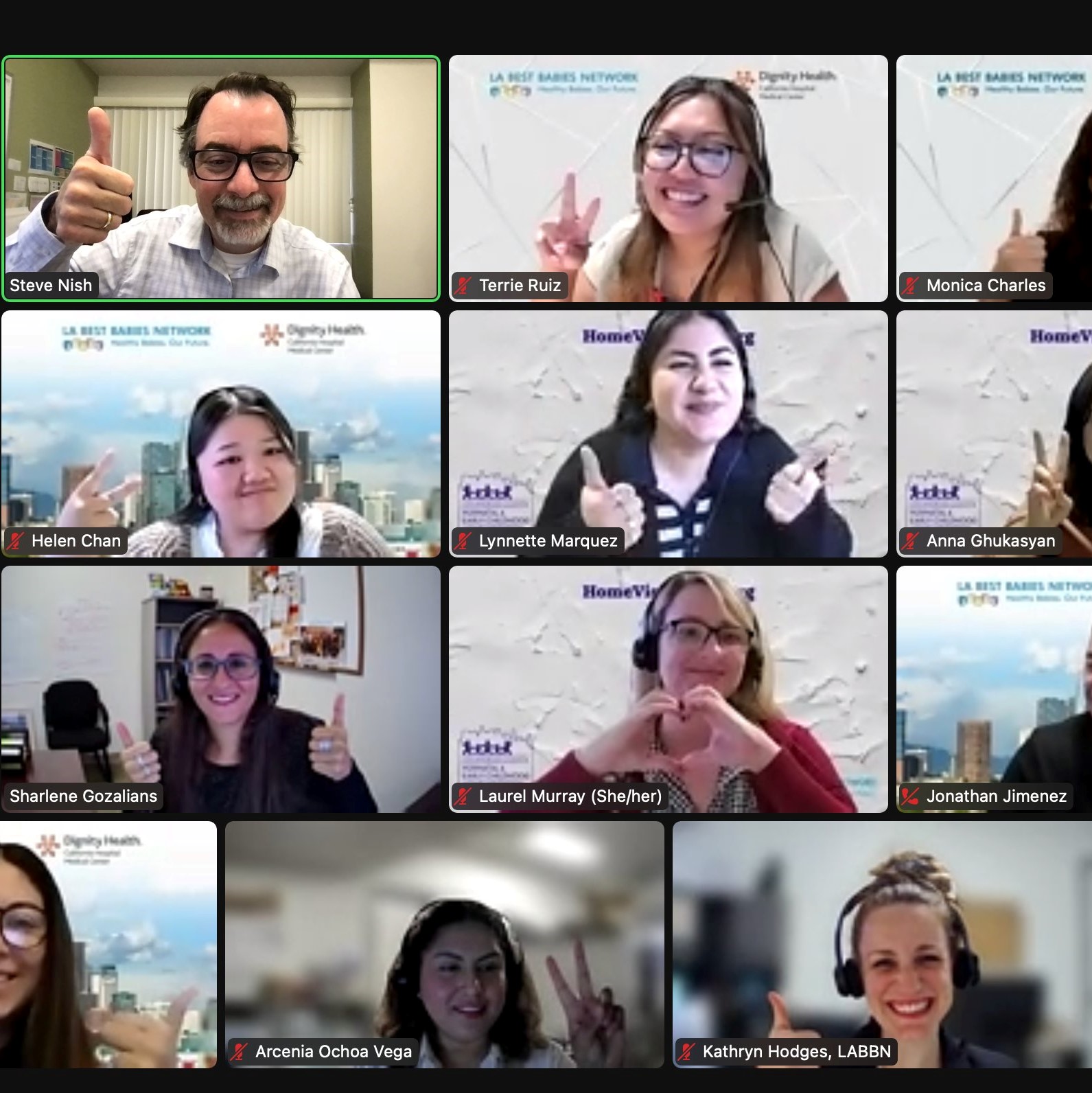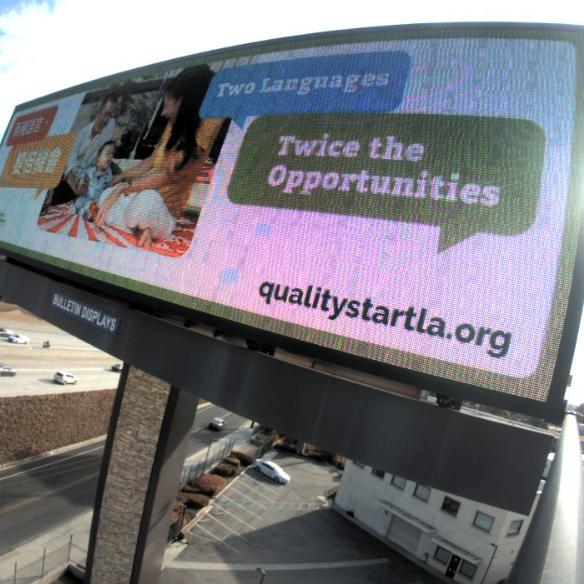Los Angeles County Child Care Planning Committee 2017 Needs Assessment
OVERVIEW
The early years of a child’s development lays the foundation for success in school. According to Harvard’s Center on the Developing Child, 700 to 1,000 new neural connections form every second in the first few years of a child’s life. To support this critical time in a child’s early learning and development, it is essential for families to have access to high-quality early care and education programs. The State of Early Care and Education in Los Angeles County: Los Angeles County Child Care Planning Committee 2017 Needs Assessment explores the resources and gaps in the early care and education system that serves young children and their families in L.A. County. This report focuses on three essential components of the early care and education system: Access to early care and education; Quality in early care and education; and the early care and education Workforce.
The report was produced as a partnership between the Los Angeles County Child Care Planning Committee, the Los Angeles County Office for the Advancement of Early Care and Education (formally known as the Los Angeles County Office of Child Care) and First 5 LA.
NEEDS ASSESSMENT PARTNERS
Los Angeles County Child Care Planning Committee: To guide the early care and education field throughout California, every county has a local child care and planning development council. The Los Angeles Child Care Planning Committee (Planning Committee) serves as the local child care and development planning council for Los Angeles County as mandated by state legislation (AB 2141; Chapter 1187, Statutes of 1991). One of the responsibilities of each Local Child Care and Development Planning Council is to conduct an assessment of child care needs in the county no less than once every five years. The mission of the Planning Committee is to engage parents, child care providers, allied organizations, community, and public agencies in collaborative planning efforts to improve the overall child care infrastructure of the County of Los Angeles, including the quality and continuity, affordability, and accessibility of child care and development services for all families.
Los Angeles County Office for the Advancement of Early Care and Education: The Los Angeles County Office for the Advancement of Early Care and Education (the Office) envisions a high quality early care and education system accessible to all families that nurtures children’s healthy growth and early learning, fosters protective factors in families, and strengthens communities. It shapes policy recommendations, facilitates planning, and provides a range of services aimed at improving the availability, quality and access to early care and education programs. As a part of its work, the Office staffs the Los Angeles County Child Care Planning Committee, as well as the Los Angeles County Policy Roundtable for Child Care and Development.
First 5 LA: First 5 LA is a leading early childhood advocate working collaboratively across L.A. County and was created in 1998 to invest L.A. County’s allocation of funds from California’s Proposition 10 tobacco tax. Since then, First 5 LA has invested more than $1.2 billion in efforts aimed at providing the best start for children from prenatal to age five and their families. First 5 LA, in partnership with others, strengthens families, communities, and systems of services and supports so all children in L.A. County enter kindergarten ready to succeed in school and life.
FINDINGS AND RECOMMENDATIONS – Access to Early Care and Education
A child’s early years are a critical period in a young person’s development. The foundation that is built through a child’s participation in quality early childhood education sets them on a path to positive economic and social impacts lasting well into adulthood, from higher educational attainment and less chance of involvement in criminal activity, to higher status employment and higher earnings (Schweinhart 2007; Sparling, Ramey & Ramey 2007). Early care and education benefits the children and families who participate and yields long lasting benefits for society as a whole. Nobel laureate in economics, James Heckman, found that the long-term, economic return on investment in high-quality early care and education programs can yeild up to a 13% return (Heckman 2016).
The 2017 Needs Assessment findings regarding early care and education access draw attention to the shortage of infant and toddler care, the decline in family child care homes, the increased participation in transitional kindergarten, and the high cost of child care.
1) There are not enough early care and education services for families with infants and toddlers.
There are approximately 650,000 children under the age of 5 in Los Angeles County, yet licensed centers and family child care homes only have the capacity to serve 13 percent of working parents with infants and toddlers. In stark contrast, there are 12 percent more licensed preschool spaces than there are preschool age children of working parents.
In addition to the overall lack of licensed spaces for infants and toddlers, subsidies to help low-income working parents cover the cost of infant and toddler care fall woefully short of the need. Subsidized early care and education programs help low-income working parents become financially stable, yet only 15 percent of eligible infants and toddlers are served, compared to 41 percent of eligible preschoolers and 53 percent of eligible school age children. A lack of care for our youngest children impacts not only working families but also affects our economy as a whole. With the extreme gap between the number of working families with infants and toddlers and the capacity of licensed early care and education providers to care for infants and toddlers, Los Angeles County faces a significant challenge.
Recommendation – Conduct a deeper analysis of the barriers to increasing the supply of infant/ toddler care:
Conduct in-depth analysis of the challenges and barriers for providers to serve infants and toddlers and identify potential solutions to those barriers. Key issues to be explored may include the financial burden of providing care to infants and toddlers; the challenge of providing the appropriate physical environment for infants and toddlers (e.g., city zoning, education code and licensing regulations, such as square footage and the requirement for napping area); the cost and need for staff professional development to appropriately care for infants and toddlers; and the low compensation of the workforce.

Recommendation – Increase investments to expand access for infant and toddler care:
Increase State and federal investments in child care subsidy programs, especially for infants and toddlers. Advocate for additional funding for subsidized infant/toddler care through increases in State programs like California Center Based Programs (CCTR) for Infants and Toddlers and Alternative Payment, as well as federal initiatives like Early Head Start.
2) The County continues to lose licensed family child care spaces for all age groups while licensed center capacity has grown.
Licensed family child care facilities, which are located in a provider’s home, offer parents an early care and education option that often has more flexible hours of operation and smaller provider-child ratios. In Los Angeles County, as of March 2016, there were 6,052 family child care providers compared to 7,623 in 2011. Over the past five years, family child care programs have experienced a decrease in their licensed capacity by 17 percent. In 2011, Los Angeles family child care providers had the capacity to serve 79,620 children, but that number dropped to 65,820 children by 2016. While it is likely that the economic recession had a major impact on this phenomenon, it is also possible that other factors such as changes in parent choice and the advent of transitional kindergarten may have had an impact.

Recommendation – Support family child care providers to provide quality care for infants and toddlers:
Develop support mechanisms for family child care providers to serve infants and toddlers, since there is a growing need for services for that age group. Strategies may include professional development, shared business services to support administrative functions, support for staff to pursue higher education opportunities, and capital improvement grants to improve family child care to accommodate infants and toddlers.
Recommendation – Conduct a study of family child care providers who have left the system:
Conduct a study with family child care providers who have decided not to renew their licenses to better understand the challenges they faced, the reasons behind their choices, the role that the economic downturn played, and other factors impacting their choice to leave the system. Family child care seems to be on the decline nationally due to low wages in the field and more career options for working women who make up the vast majority of the family child care workforce. This study would explore geographic differences in the density of family child care and factors that have led to successful family child care homes. Finally, the study would look at the dynamics between center-based care and family child care to better understand issues of access and parent choice.
3) Preschool age children are participating more and more in transitional kindergarten.
The most recent addition to the early care and education system in California is transitional kindergarten (TK), which was established by the School Readiness Act of 2010 (SB 1381). Transitional kindergarten (TK) is the first of a two-year kindergarten program. It uses a modified curriculum that is age and developmentally appropriate, is taught by a credentialed teacher, and is funded through Average Daily Attendance (ADA) funds.
Eligibility for transitional kindergarten is extended to children whose fifth birthday falls between September and December of the academic school year. In 2015, it was clarified that the School Readiness Act also allows school districts to enroll children who will turn 5-years-old after the December cutoff date. This option is called expanded transitional kindergarten (ETK) and is funded through a combination of local and ADA funding. In the 2014-2015 school year, 20,499 Los Angeles County children participated in transitional kindergarten—a 33 percent increase from the prior school year.
As more and more families become aware of this publicly funded option for their children, it is likely that the number of participating children will continue to grow. The arrival of transitional kindergarten has had, and will continue to have, a major impact on the early care and education system within California. As the field moves into this new era, it is essential that the entire early care and education system (inclusive of local education agencies) works together to meet the needs of young children in the County.

Recommendation – Establish a mixed-delivery system early care and education taskforce:
Establish a mixed-delivery taskforce to assess the current birth-5 early care and education system, identify system best practices, explore alignment and coordination opportunities between local education agencies and licensed early care and education providers, discuss policy solutions, and propose recommendations. The taskforce would consist of leaders from various birth-5 early care and education sectors like Resource and Referral Agencies; federally funded programs like Head Start and Early Head Start; local school districts; Los Angeles County Office of Education; First 5 LA; Los Angeles County Office for the Advancement of ECE; Los Angeles County Department of Public Social Services (CalWORKS Stage 1); and California Department of Education funded programs like the California State Preschool, California Center Based Programs, and Alternative Payment.
4) Early care and education is a costly expense for many families.
The cost of care for a young child is high. A family’s average cost of care in Los Angeles County is $10,303 a year per preschooler in center-based care and $8,579 a year per preschooler in a family child care home. Care for infants and toddlers is even more expensive, with an annual cost of $14,309 in an early care and education center and $9,186 in a family child care home. Families earning the Los Angeles County median family income of $54,194 pay 16-26 percent of their wages per child for early care and education services. If a family has two children, an infant and a preschooler in center-based care, they would need to spend nearly half of their income (45 percent) on care for their children.
For families with income below the poverty line, the situation is even more dire. According to a report published by the Public Policy Institute of California, in 2013, Los Angeles County had the highest rate of poverty in the State, with 21 percent of the residents living in or near poverty. It is estimated that 27 percent of children in our County under 18 years old live in poverty. Over 900,000 children live in households with earnings 70 percent below the State Median Income (SMI). Even though the California minimum wage has increased, income eligibility for subsidized child care has not increased since 2011. According to the Child Care Law Center, income eligibility was frozen at 70 percent of the State Median Income used in Fiscal Year 2007-2008, which itself was based on 2005 income data. This barrier is encountered by many low-income working parents looking for subsidized care, since they often do not meet the income requirements for eligibility. With the minimum wage increasing to $15 per hour by 2021, low income earning parents who receive slight wage increases may no longer be eligible for subsidized care.

Recommendation – Support increasing the income eligibility cap for subsidized early care and education for low-income families:
Update the eligibility guidelines to reflect the current State Median Income (SMI) and establish up to 12 months of income eligibility for families up to 85 percent of the SMI.
FINDINGS AND RECOMMENDATIONS – Quality in Early Care and Education
Every parent should be able to have their child participate in a high-quality early care and education program. After analyzing 20 studies on the impact of child care quality on children’s outcomes, Burchinal et al. (2011) found that there is a relationship between child care quality and children’s academic achievement, as well as language and cognitive development. To increase the quality of care, Quality Rating and Improvement Systems (QRIS) have emerged across the country. A first step for an early care and education program to participate in QRIS is to be licensed and in good standing. The core mission of the Child Care Licensing Program is to ensure the health and safety of children. With licensing being the entry level to QRIS, participating providers are then assessed on essentials of quality such as child development and social readiness, teacher qualifications and adult-child interactions, and program environment. QRIS assesses these elements and provides a rating on a five-point rating scale. Although the rating serves as a starting point, the most valuable component of QRIS lies in the ongoing quality improvement support. QRIS early care and education providers receive an abundance of tools, training and coaching to strengthen the quality of their program. Findings to take into consideration in this section of the report include the limited amount of QRIS rated sites in Los Angeles County, and the current QRIS focus on state-funded and center-based care.
1) While the number of QRIS rated sites has increased, only a limited percentage of Los Angeles County providers have been QRIS rated.
Over the last 10 years, Los Angeles County has been building its QRIS system from both local funding from First 5 LA and First 5 CA, as well as federal investments like the Race to the Top- Early Learning Challenge. Although this funding has laid a foundation for a county-wide QRIS system, and there has been substantial progress in reaching more and more providers, there is still a long way to go to reach all providers. As of June 30, 2016, when federal funding for QRIS through the Race to the Top Early Learning Challenge grants ended, 252 family child care homes were rated, and 619 early care and education centers were rated. This represents a mere 4 percent of family child care homes and 18 percent of center-based programs in Los Angeles County.
While the federal funding for QRIS has ended, the California Department of Education is currently providing QRIS on-going funding for California State Preschool Programs and a one-time QRIS block grant for programs that serve infants and toddlers that is slated to end in September 30, 2017. In addition, First 5 California has invested in QRIS across the State through First 5 IMPACT (Improve and Maximize Programs so All Children Thrive), and First 5 LA continues to be committed to QRIS.

Recommendation – Increase On-Going QRIS Funding:
Expand on-going investments in QRIS, especially for programs that serve infants and toddlers. Strategies may include expanding funding for the California State Preschool Program (CSPP) Quality Rating and Improvement System (QRIS) Block Grant, continuing the Infant/Toddler Quality Rating and Improvement System (QRIS) Grant Program, and expanding QRIS support to include additional programs in the early care and education care system.
2) To date, QRIS has been primarily focused on state-funded and center-based care.
Every community has different strengths, challenges and needs. Early care and education in Los Angeles County is a complex tapestry of various funding streams, curriculums and structures. Low-income children, emergent bilinguals, children in the child welfare system and children with special needs all have unique requirements that providers need the skills and resources to meet. As of June 30, 2016, less than 35 percent of the licensed early care and education centers and family child care homes that participated in QRIS were rated in the higher tiers of three, four, or five. To ensure the needs of Los Angeles County’s children can be served by high-quality early care and education programs, public funding to support local QRIS efforts has to be reasonably flexible. By providing more flexibility for QRIS, funding could be braided, and QRIS could more easily target providers who serve the children most at risk of not being prepared for school success.

Recommendation – Promote flexibility in the use of QRIS funds to best meet the needs of local communities:
Advocate for Los Angeles County to have local control over how to spend QRIS dollars to support the diverse needs of its community. Funders should provide the local QRIS system with the flexibility to allocate money where it is most needed in the county.
Recommendation – Continue building a single QRIS model in Los Angeles County through the QRIS Architects:
Refine QRIS to best serve Los Angeles’ children through the QRIS Architects. The QRIS Architects is a collaborative of seven organizations working collectively to develop a countywide QRIS that addresses the quality improvement needs of different licensed provider types; strengthens relationships between QRIS participants for successful implementation; and enhances the QRIS infrastructure, so that it is efficient and able to be expanded.
Members of the QRIS Architects include the Child Care Alliance of Los Angeles, the County of Los Angeles Child Care Planning Committee, First 5 LA, Los Angeles County Office of Education, Los Angeles Universal Preschool (LAUP), County of Los Angeles Office for the Advancement of Early Care and Education, and Partnerships for Education Articulation and Coordination through Higher Education (PEACH).
FINDINGS AND RECOMMENDATIONS – The Early Care and Education Workforce
The quality of early learning programs for children is intrinsically connected to the early care and education workforce. Numerous studies (e.g. Shonkoff & Phillips, 2000; Whitebook, 2003; Tout, Zaslow & Berry, 2006; Kelley & Camilli, 2007) have cited how members of the ECE workforce who are more educated and have specialized training not only provide children with better quality care, but the children in their care have been found to make greater developmental gains than their counterparts. The key to enhancing the quality of the early care and education system lies in the professionalization of the workforce. In this early care and education workforce section of the report, findings highlight challenges faced by the ECE workforce including low wages, the limited education of the workforce, and barriers to accessing professional development.
1) The early care and education workforce earn low wages.
Although there is a growing public awareness about the critical importance of the early years of a child’s life, and many families rely on the early care and education workforce to nurture the early learning of our youngest children, these professionals are often paid close to minimum wage and dramatically less than teachers of older children. In California, child care professionals earn a median hourly wage of $11.61, and preschool teachers earn a median hourly wage of $15.25, compared to kindergarten teachers who earn a median hourly wage of $30.74. Teaching infants, toddlers and preschool age children requires the equivalent level of skills and knowledge as teaching older children, yet the pay is over 50 percent lower. In Los Angeles County, early care and education professionals make an average of $14.65 per hour. More specifically, in Los Angeles County, center-based early educators make an average of $14.75 per hour, whereas those who work in family child care make $11.73 per hour.
California has a dual subsidized child care system, and subsidized licensed early care and education providers are paid by two separate and different reimbursement rates depending on the source of funding. The current system is split into two distinct reimbursement structures: the Standard Reimbursement Rate (SRR) for Title 5 Contracted Center Based Programs, and the Regional Market Rate (RMR) for Alternative Payment and CalWORKs child care programs. Early care and education providers serving a child enrolled in the Alternative Payment and/or CalWORKs programs are reimbursed at their established rate up to the Regional Market Rate (RMR) ceilings established by the State. Effective January 1, 2017, the Regional Market Rate (RMR) ceilings were established at the 75th percentile of the 2014 regional market rate survey. Establishing the ceiling at the 75th percentile means that low-income families enrolled in these programs have access to approximately 75 percent of the providers in their community. However, since the current RMR is out of date and is based on the 2014 regional market rate study, families enrolled in these programs have fewer choices, which can impact the quality of care they are able to choose for their children. The current daily RMR ceilings for full-time care at a center-based program in Los Angeles County is $90.68 per infant/toddler and $64.21 per preschooler, while at a family child care, the daily rate for full time care is $51.77 per infant/toddler and $50.44 per preschooler.
Title 5 contracted providers who have General Child Care and the California State Preschool Program contracts with the Department of Education receive a Standard Reimbursement Rate. In January 2017, the Standard Reimbursement Rate (SRR) increased by 10 percent bringing the daily rates per child to $42.12 for general child care programs, $26.26 for part-day state preschool, and $42.38 for full-day state preschool programs. Existing rates simply do not cover the providers’ full costs, particularly for high quality child care. In addition, recent increases to the minimum wage have increased provider costs further and will continue to do so as minimum wages rise over the next four years. Without additional increases to the SRR, programs will find it difficult to raise employee wages to meet the new requirements. Any increases to the minimum wage should automatically trigger comparable increases to the reimbursement rate.
The next step toward building a better reimbursement system for child care and early learning programs throughout California would be to merge the two existing rate structures into a single reimbursement system that maintains both child care options and reflects the actual current cost of care in each region/ county with a base at the 85th percentile level.
Recommendation – Raise the Regional Market Rate for early care and education providers:
Increase the Regional Market rate for reimbursements to subsidized early care and education providers to 85th percentile of the most recent market rate.
Recommendation – Maintain the Standard Reimbursement Rate for early care and education providers:
Maintain the Standard Reimbursement Rate increase of 10% approved in the 2016-2017 California State Budget.

Recommendation – Adopt a single reimbursement rate for all California early care and education providers:
Advocate to the State legislature and administration to adopt and implement a new, single reimbursement rate that covers the actual cost of infant/toddler and preschool care and education in each region/county with a base at the 85th percentile level.
2) Early care and education staff have limited education.
High quality early care and education for young children is inherently linked to a highly-qualified workforce, yet approximately half of the local workforce does not possess a college degree. In a 2015 report, the Institute of Medicine and the National Research Council concluded that all lead teachers in the nation’s preschools should have a bachelor’s degree in early childhood development or early education. Higher education is one of the most important pathways needed to professionalize the field. Based on a recent study of ECE providers who participated in First 5 LA funded professional development programs, only 24 percent of center based providers had an associate’s degree, 21 percent had a bachelor’s degree, and 5 percent had an advanced degree. Family child care providers in the study had lower education levels than the center based as a whole, 17 percent had an associate’s degree, 13 percent had a bachelor’s degree and 6 percent had an advanced degree. California does not have a teaching credential for early childhood educators, but instead has a Child Development Permit. Currently, only 63 percent of Los Angeles County’s Early Care and Education workforce has a California Child Development permit.
.gif)
Recommendation – Expand pathways and supports for the early care and education workforce to pursue higher education:
Increase accessibility for programs that support higher education for early care and education professionals. Supports may include college tuition support; education advisors; flexible class times; and the availability of courses, books, and technology in languages in addition to English. Strategies for institutions of higher education include identifying ways to support degree-granting institutions, strengthening the articulation of coursework from community colleges to 4-year universities, and funding college faculty to map and align their courses with the Early Childhood Education Competencies.
Recommendation – Establish a formal teaching credential in California that prepares educators to work with children 0-8 year olds:
Advocate for a 0-8 teaching credential in California. Credentialed teachers strengthen the Early Care and Education system by increasing the quality of education and care given to children, lowering teacher turnover rates, providing a smoother transition for children, and increasing the capacity of all teachers to work with diverse families.
3) Cost is a barrier to early care and education providers accessing professional development.
When asked about professional development, early educators reported that their number one reason to participate in professional development is to increase their knowledge, yet the top barrier they shared is not having enough money for tuition or training expenses. It is essential to connect members of the early care and education workforce to free and low-cost training opportunities.
Recently, the California Early Care and Education Workforce Registry was launched in both San Francisco and Los Angeles County with funding from the Mimi and Peter Haas Fund, the David and Lucile Packard Foundation and First 5 LA. The online database is designed to track and promote the education, training and experience of the early care and education workforce to improve professionalism and workforce quality and positively impact children. After an early educator signs-up for the registry, he/ she can access and sign up for the most up-to-date trainings. With all the requisite available trainings in one place, the registry serves as an efficient tool in assisting members of the ECE workforce to accelerate their professional development. Although this system has made significant gains, it needs to garner on-going funding to be able to include all members of the workforce.

Recommendation – Expand free and low-cost professional development opportunities: Increase funding for free and low/cost training, coaching, and mentoring for early care and education providers. It is important that strategies considered are provided in languages in addition to English including training instruction and program curricula.
Recommendation – Improve information systems to support professional development through the California Early Care and Education Workforce Registry:
Advocate for on-going public funding to support the California Early Care and Education Workforce Registry. As a professional development strategy, the registry would increase access to professional development, monitor the impact of professional development supports, and standardize data collection practices to track the movement of the workforce.
ADDITIONAL INFORMATION
For more information about The State of Early Care and Education in Los Angeles County: Los Angeles County Child Care Planning Committee 2017 Needs Assessment, please contact Michele Sartell atms******@ce*.gov"> ms******@ce*.gov">ms******@ce*.gov. The full report may be downloaded at www.childcare.lacounty.gov.
